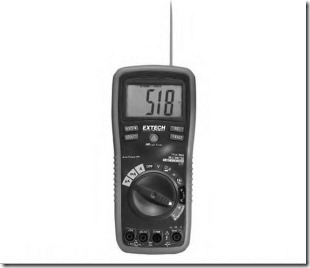est instruments are vital to electric motor maintenance and troubleshooting. Lost production makes reactive maintenance (“wait until it smokes”) much too costly. Proper application of the right instrument, combined with a good understanding of electric motors, results in quick, accurate decisions.
A reputable organization such as the Electrical Apparatus Service
Association (EASA), a worldwide organization of electric motor repair centers ![]() should be consulted before investing in expensive test equipment. An instrument salesperson must be able to show the Institute of Electrical and Electronics Engineers (IEEE) or National Electrical Manufacturers Association (NEMA) standards that verify the values, specifications, and pass/fail limits that are failure indicators. Many of the so-called limits don’t exist.
should be consulted before investing in expensive test equipment. An instrument salesperson must be able to show the Institute of Electrical and Electronics Engineers (IEEE) or National Electrical Manufacturers Association (NEMA) standards that verify the values, specifications, and pass/fail limits that are failure indicators. Many of the so-called limits don’t exist.
Services that require special training, such as balancing, surge testing, and particle analysis, are offered by electric motor service centers and bearing companies. Many industries outsource these services rather than train their own personnel.
The first part of this chapter covers the first instruments used to troubleshoot a motor problem. The second part is on instruments and tests that are sometimes outsourced.
Instruments for Initial Testing
Instruments for initial testing include
• Voltmeter (with infrared temperature capability)
• Ammeter (clamp-on)
367
• Ohmmeter (multimeter with built-in infrared thermometer)
• Microhmmeter
• Tachometer (with vibration meter)
• Megohmmeter (megger)
• Infrared gun
• Stethoscope
Voltmeter
The voltmeter (Fig. 8.1) is usually the first troubleshooting instrument used. Even if the problem is obvious, such as a smoking motor, checking the voltage may reveal the reason for a motor’s failure. In addition, it verifies that the power is off (for safety concerns).
FIGURE 8.1 The voltmeter/infrared thermometer is the first instrument used when troubleshooting. EXTECH Instruments.
A voltmeter tests for line-to-line comparison at the motor’s disconnect switch and at the motor’s leads (preferably under load). It tests for voltage unbalance (unbalance should not be over 1 percent), an open line, and high or low voltage.
Voltage unbalance will cause a motor to run hot—even if it is not fully loaded—and eventually fail. It’s caused by faulty connections, faulty incoming power, and severe upstream load unbalance. A blown fuse will show a voltage reading across it.
This voltmeter has infrared temperature capability. Infrared should be used in the initial test. Check the pulley for heat caused by excessive slippage/worn grooves, shaft end bearing journal, and the stator. This information is valuable in determining the breakdown cause.
Three-phase motors won’t start when there’s an open line. Their power drops to about half if they are running when the line opens. The open line may show a voltage reading because voltage is fed back through loads that are online. It can be verified by opening the suspected line. Remove the fuse or open the disconnect. There will be no change in the (load side) voltage reading if this is the open line.
High voltage (above 10 percent of the motor’s rating) can be caused by power factor correcting capacitors that are online when they aren’t needed.
Power suppliers sometimes raise the voltage to compensate for voltage drop caused by a maximum load. High voltage develops when the load is switched off.
Low voltage causes include inadequate wire size (too much voltage drop after load is applied), undersized transformer, wrong voltage (more than 10 percent below the motor’s rating), severe load unbalance, and overloaded main feeder circuit.
AC and DC voltmeters for troubleshooting DC machines are covered in Chapter 2. The voltmeter compares the voltage drop across coils (shunt field ![]() series field, and interpoles), reads from brush to commutator (contact drop), checks interpole polarity, checks for continuity between shunt and series field coils, and measures bar-to-bar voltage.
series field, and interpoles), reads from brush to commutator (contact drop), checks interpole polarity, checks for continuity between shunt and series field coils, and measures bar-to-bar voltage.
Clamp-on Ammeter
An ammeter (Fig. 8.2) is used on a motor that runs hot and is noisy (excluding bearing noise), and on a motor that starts more slowly than normal. It also tests for line-to-line current unbalance.
FIGURE 8.2 The clamp-on ammeter (with ohmmeter function) gives amperes without touching any live conductors. EXTECH Instruments.
Causes of high ampere reading include overload, faulty bearings, shorted winding, open winding, faulty rotor, and voltage problems (covered under the preceding section, “Voltmeter”).
A digital ammeter set on high-ampere lockout can be used to estimate locked rotor current (see “Code Letter” in Chapter 5).
The ammeter should always be used on a replacement motor following installation. The best place to take an ampere reading is at the motor leads, under full load.

![clip_image004[5] clip_image004[5]](http://machineryequipmentonline.com/electric-equipment/wp-content/uploads/2017/05/clip_image0045_thumb.jpg)